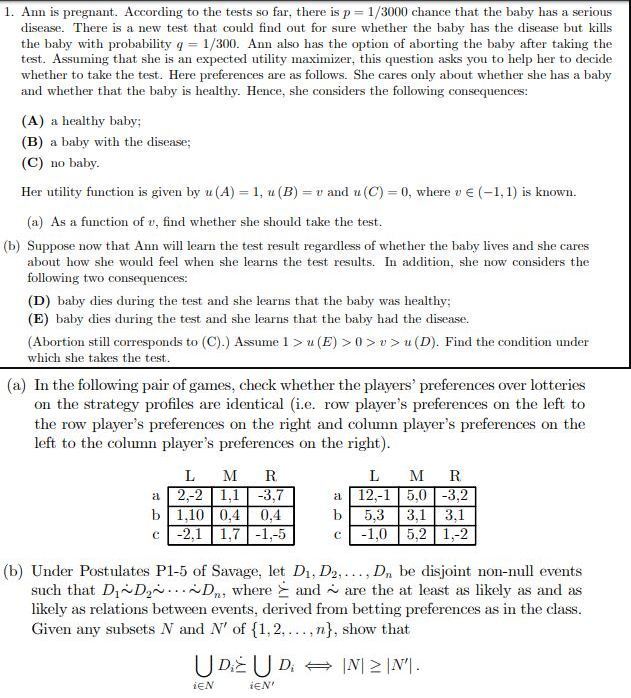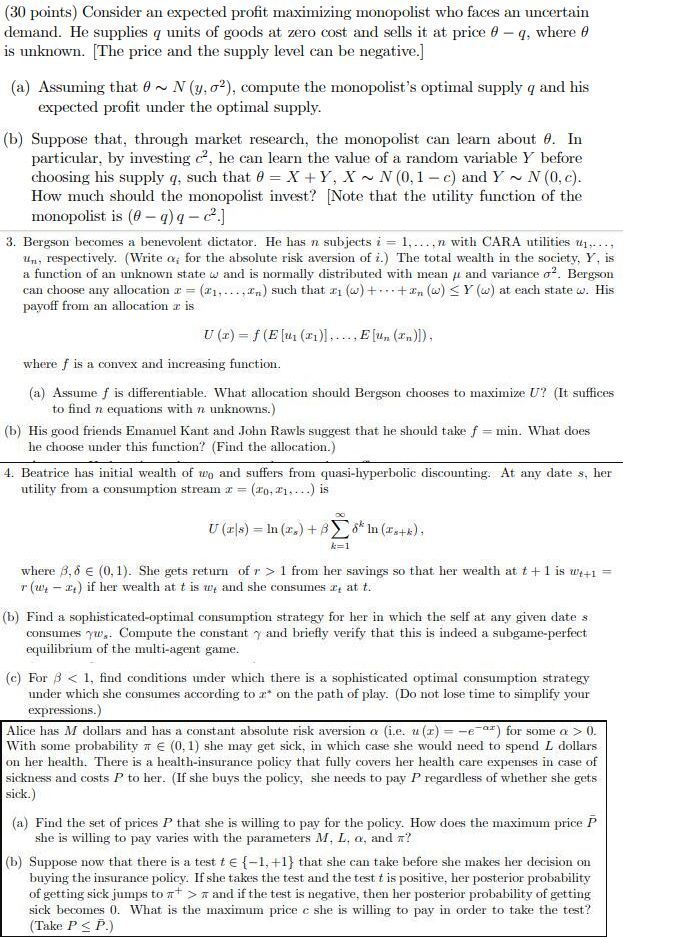Questions on microeconomics, try and provide a solution for these
1. Ann is pregnant. According to the tests so far, there is p = 1/3000 chance that the baby has a serious disease. There is a new test that could find out for sure whether the baby has the disease but kills the baby with probability q = 1/300. Ann also has the option of aborting the baby after taking the test. Assuming that she is an expected utility maximizer, this question asks you to help her to decide whether to take the test. Here preferences are as follows. She cares only about whether she has a baby and whether that the baby is healthy. Hence, she considers the following consequences: (A) a healthy baby; (B) a baby with the disease; (C) no baby. Her utility function is given by u (A) = 1, u (B) = v and u (C) =0, where ve (-1, 1) is known. (a) As a function of v, find whether she should take the test. (b) Suppose now that Ann will learn the test result regardless of whether the baby lives and she cares about how she would feel when she learns the test results. In addition, she now considers the following two consequences: (D) baby dies during the test and she learns that the baby was healthy; (E) baby dies during the test and she learns that the baby had the disease. (Abortion still corresponds to (C).) Assume 1 > " (E) > 0 > > > u (D). Find the condition under which she takes the test. (a) In the following pair of games, check whether the players' preferences over lotteries on the strategy profiles are identical (i.e. row player's preferences on the left to the row player's preferences on the right and column player's preferences on the left to the column player's preferences on the right). L M R L M R 2.-2 1,1 -3.7 12,-1 5.0 -3.2 1,10 0,4 0,4 5.3 3,1 3.1 -2,1 1,7 -1,-5 -1,0 5,2 1,-2 (b) Under Postulates P1-5 of Savage, let D1, D2. .... D,, be disjoint non-null events such that Di~Dy~. . .~Dn, where > and ~ are the at least as likely as and as likely as relations between events, derived from betting preferences as in the class. Given any subsets N and N' of {1, 2. ..., n}, show that UD UD - IN12 INI. iEN iEN!(30 points) Consider an expected profit maximizing monopolist who faces an uncertain demand. He supplies q units of goods at zero cost and sells it at price 0 - q, where d is unknown. [The price and the supply level can be negative.] (a) Assuming that 8 ~ N (y. o'), compute the monopolist's optimal supply q and his expected profit under the optimal supply. (b) Suppose that, through market research, the monopolist can learn about 0. In particular, by investing c', he can learn the value of a random variable Y before choosing his supply q, such that 0 = X + Y, X ~ N (0, 1 - c) and Y ~ N (0, c). How much should the monopolist invest? [Note that the utility function of the monopolist is (0 - q) q - c2.] 3. Bergson becomes a benevolent dictator. He has a subjects i = 1,... .n with CARA utilities u1,. . ., Un, respectively. (Write o, for the absolute risk aversion of 2.) The total wealth in the society, Y, is a function of an unknown state w and is normally distributed with mean / and variance of. Bergson can choose any allocation . = (21,...,2,) such that an (w) + +2, (w) 1 from her savings so that her wealth at t + 1 is w4+1 = "(wt - It) if her wealth at t is ary and she consumes r, at t. (b) Find a sophisticated-optimal consumption strategy for her in which the self at any given date s consumes yu's. Compute the constant y and briefly verify that this is indeed a subgame-perfect equilibrium of the multi-agent game. (c) For 8 0. With some probability # 6 (0, 1) she may get sick, in which case she would need to spend L dollars on her health. There is a health-insurance policy that fully covers her health care expenses in case of sickness and costs P to her. (If she buys the policy, she needs to pay P regardless of whether she gets sick.) (a) Find the set of prices P that she is willing to pay for the policy. How does the maximum price P she is willing to pay varies with the parameters M. L. o, and a? (b) Suppose now that there is a test te {-1, +1} that she can take before she makes her decision on buying the insurance policy. If she takes the test and the test t is positive, her posterior probability of getting sick jumps to a * > * and if the test is negative, then her posterior probability of getting sick becomes 0. What is the maximum price c she is willing to pay in order to take the test? (Take P








